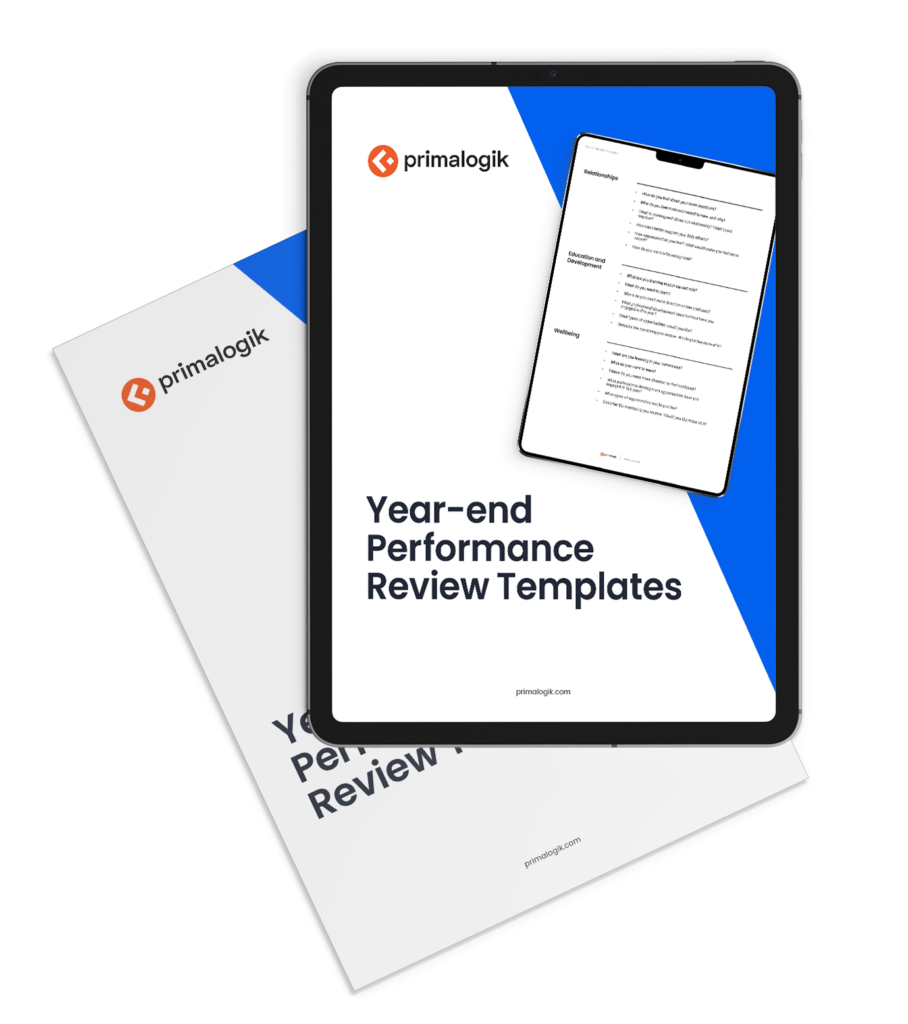Daily and weekly feedback is vital to performance management. However, the year end review allows for a thorough evaluation of progress over a longer time frame. Managers can take this opportunity to reflect on all the milestones and feedback conversations from the past year. With this data, they can identify trends and make a plan for further growth.
Giving a thoughtful year end review holds particular importance on a remote or hybrid team. Managers of such teams need to be highly intentional about providing feedback. Why? Employees who work remotely part- or full-time can easily feel disengaged or confused about how they’re doing.
Having an in-depth discussion of how they’re performing will bring the clarity they need. It’s a great way to bookend the year and prepare for the new one.
Navigation
1. What Happens in A Year End Review?
2. Common Year End Review Mistakes
3. How Managers Can Make the Most of the Review
4. How Employees Can Get the Most from Their Review
1. What Happens in A Year End Review?
In a year end review, a manager evaluates whether employees have met their goals. The manager tells them whether they have measured up to (or surpassed) expectations. They discuss strengths and weaknesses and pinpoint areas for growth. Additionally, the manager works with employees to set new goals and a plan for achieving them.
Employees leave a well-delivered review with valuable insights on their performance and how to improve.
The year end review can also determine whether the employee should receive a promotion or raise. In some cases, the manager may inform the employee that she is receiving a promotion during the review itself. In other cases, the manager consults with other leaders after the review to make these decisions.
Managers may also let employees know about any bonuses they will be receiving during this meeting.
2. Common Year End Review Mistakes

Avoid these common year end review blunders. Help employees focus on your valuable feedback. Steering clear of these pitfalls will help you have an open and productive conversation.
Discussing negative personality traits:
While employees will hardly mind if you mention positive personality traits, don’t highlight negative traits. Instead, speak of behaviours. This de-personalizes the issues, emphasizing that the employee can change. For instance, don’t say, “You’re unreliable because you always overpromise what you have capacity for.” Say, “You seem to be saying ‘yes’ to many requests that can’t fit into your current workload.”
Making general statements without well-grounded evidence:
“If you say, ‘I don’t feel you handle customer complaints as well as you should,’ make sure you have at least two specific examples to share. That way, you can also discuss how those situations should have been handled,” writes Jeff Haden in Inc.
Comparing employees to their peers:
This is a sure way to spark resentment. It can also lead to contrast bias: a mistakenly low perception of the employee because you’re using the wrong standard. Compare individual employees against their own past performance—no one else’s.
Falling prey to other common types of bias:
For example, with the “halo” bias, a manager has an overly positive perception of an employee because of her strengths in one or two areas. With the “horns” bias, the opposite occurs. And recency bias can overemphasize more recent events, whether positive or negative.
Relying too heavily on the year end review:
The annual review should mark a culmination of 12 months filled with one-on-one meetings and check-ins. (And if you opt for six-month or quarterly reviews in place of one annual review, that’s completely fine, too!)
These tips will not only enhance understanding; they’ll also boost feelings of goodwill during the review. Employees will leave knowing their manager genuinely cares about them. Plus, they’ll have the tools to make changes where needed.
3. How Managers Can Make the Most of the Year End Review

Giving a great year end review doesn’t come naturally. Managers don’t practice this skill every day, after all. Even the best ones need guidance from HR on how to navigate the process.
Performance reviews should have three essential qualities, Gallup asserts:
- Achievement-oriented
- Fair and accurate
- Developmental
Gallup found that high-performing teams integrate these core qualities into their formal reviews. Using the following strategies, managers can ensure their reviews focus on achievement, fairness, and development.
Use a standardized year end review appraisal form
HR should keep these forms for all managers to use. SHRM offers an appraisal form with a rating scale. The form should primarily include rating questions rather than open-box questions.
Why? Researchers at the Stanford VMware Women’s Leadership Lab found that open-box questions tend to lead to bias. They’re more subjective; managers may innately focus on certain qualities for men and others for women, for example. “Open box = open to bias,” Harvard Business Review writes. “Men were more likely to receive longer reviews that focused on their technical skills, compared to shorter reviews for women that were more concerned with their communication skills.”
Following a clear rubric with the appraisal form will help. The rubric provides criteria for assessing employees, serving as a guide to evaluation.
Check on employee wellbeing
Consider personal struggles employees may have faced this year. Adapting to a new normal has brought challenges for most of us. Ongoing stress may have affected people’s productivity and focus. Discuss ways of coping with these challenges in the coming months. Also, offer support and resources wherever possible, like access to counseling or time-management help.
Use the right year end review tools
Use performance review software that tracks the feedback you’ve given over time. Instead of racking your brain for what to say, you’ll have a clear log of your input. This allows you to describe patterns and evaluate progress. These tools don’t just make life easier for managers. They help them actively avoid bringing personal bias into their reviews. Rather than coming to conclusions based on their personal beliefs, they’ll look at clear evidence.
Share key themes in advance
Give employees a quick overview of the main themes of the feedback you’ll be discussing. Employees should come to the review with a good idea of what to expect.
Say something like, “Overall, you’ve met most of my expectations and surpassed a few. I want to discuss where your interpersonal skills really shone and a couple of areas where they can grow. I also want to hear which professional development opportunities proved most valuable. And let’s discuss what you found challenging about projects Y and Z. We can discuss how to overcome those issues. Finally, we can lay out a plan for your development over the coming year.”
Compare feedback against last year’s review and self-assessment
Look at the feedback you gave last year. How does it compare against what you’ve observed in the current review period? Also, compare the employee’s current and prior self-assessments. “This allows you to get into their brains and see how they are perceiving their work,” says career coach Nancy Von Horn of Korn Ferry Advance.
Calibrate year end review results among managers
Using performance calibration can help managers ensure they’re rating employees fairly. This involves holding a meeting for managers as they prepare for their reviews. At this point, they’ve completed preliminary evaluations for employees but haven’t delivered the formal reviews.
In this meeting, managers discuss how they arrived at their ratings. Peers and HR can provide feedback, and managers can adjust ratings if needed. Through this step, managers learn to make stronger assessments with every review cycle. And HR can help identify any biases before reviews are delivered.
“Managers may be asked why someone is a ‘4’ and not a ‘3’ — and to justify that decision with data and examples. Similarly, they may be asked why someone whose work is highly regarded wasn’t rated a ‘4’ or a ‘5,’” writes the Society for Human Resource Management (SHRM).
Collaborate on goal-setting
“While only three in 10 employees strongly agree their manager involves them in goal setting, these employees are four times more likely to be engaged than other employees,” writes Gallup. Set goals hand-in-hand with employees so they’ll feel invested in achieving them. This can happen either at the year end review or at a follow-up meeting soon after.
Ask for feedback
Ask for input on your performance as a manager. Employees have valuable feedback about how you can better lead them. They may also have similar input for the department or company. While the majority of the review should focus on the employee, devote a few minutes to hearing their perspective.
4. How Employees Can Get the Most from Their Year End Review

Encourage your managers to share the following tips with their employees. Or, HR could lead a short workshop with all employees on how to get the most from their year end review. When employees take a proactive role in the process, they’ll have a more productive conversation.
Complete a self-assessment
Encourage employees to complete a self-appraisal in preparation for their annual review. SHRM offers a template for self-appraisals. Employees should complete it prior to the review—ideally, at least a couple of days beforehand. Through the self-appraisal, they can point out major contributions their manager may have forgotten about.
Sum up accomplishments
Create an elevator pitch for your year. Summarize the year in a single sentence, Fast Company advises. Highlight three or four main achievements, backed by sound evidence.
How to refresh your memory about your successes? Keep a “Yay Me!” file of your accomplishments throughout the year, suggests Business Insider. This will give you plenty of highlights to draw from. Consider “human skills” like learning to mentor others as well as technical skills.
Explain the steps you have taken to grow your skills, too. Concisely share the educational opportunities you have pursued. Articulate how you and the company have benefitted as well.
Show self-awareness
Bring constructive feedback about your own performance. This will show you have the self-awareness to notice your mistakes and weaknesses. Identify areas for improvement and create a CTA for yourself regarding professional development.
Describe key challenges
Outline your most challenging projects and how you persevered. Address how they pushed you to grow new skills or handle new responsibilities. Mention people with whom you’ve collaborated so your manager can reach out to them if need be.
Reflect on potential goals
Bringing several new goals for yourself will show a lot of foresight. Bring three tangible goals you believe you can achieve in the coming year. Concisely explain how you plan to achieve them. And point out the overlap between your own (past and future) goals and the company’s mission. This will highlight your aptitude for big-picture thinking.
Handle constructive feedback calmly
If you receive negative feedback or are dissatisfied with your review, don’t think catastrophically. You probably have several months to turn a negative perception around. “The key to moving forward is to get past the emotional reaction and turn the information into action,” says organizational psychologist Cabot Jaffee in a Bloomberg interview.
Assert your personal goals
Your career goals can help shape the goals you and your manager set for the coming year. They’ll also guide the professional development you pursue. If you feel your role has expanded and you deserve a salary increase, make that known. If you’re interested in a new position, tell your manager. Your supervisor needs to know your professional goals so you can find the job satisfaction you deserve! If you need more time to discuss opportunities for advancement, initiate a follow-up meeting.
HR can play a pivotal role in helping both managers and employees prepare for their reviews. By ensuring everyone understands the purpose and criteria involved, you’ll help the process go smoothly. Each employee will receive valuable input, and managers will have an engaged and energized team.
Year-end Performance Review Templates
Wondering what type of questions to include in a year-end performance review? To help you get started, we’re providing 2 different templates that can be used for your next year-end performance review!
Want to make the most of your year end review? Request a demo of our performance review software. It will help all managers prepare thoroughly for their reviews. It gives employees the valuable input they want and need too!






